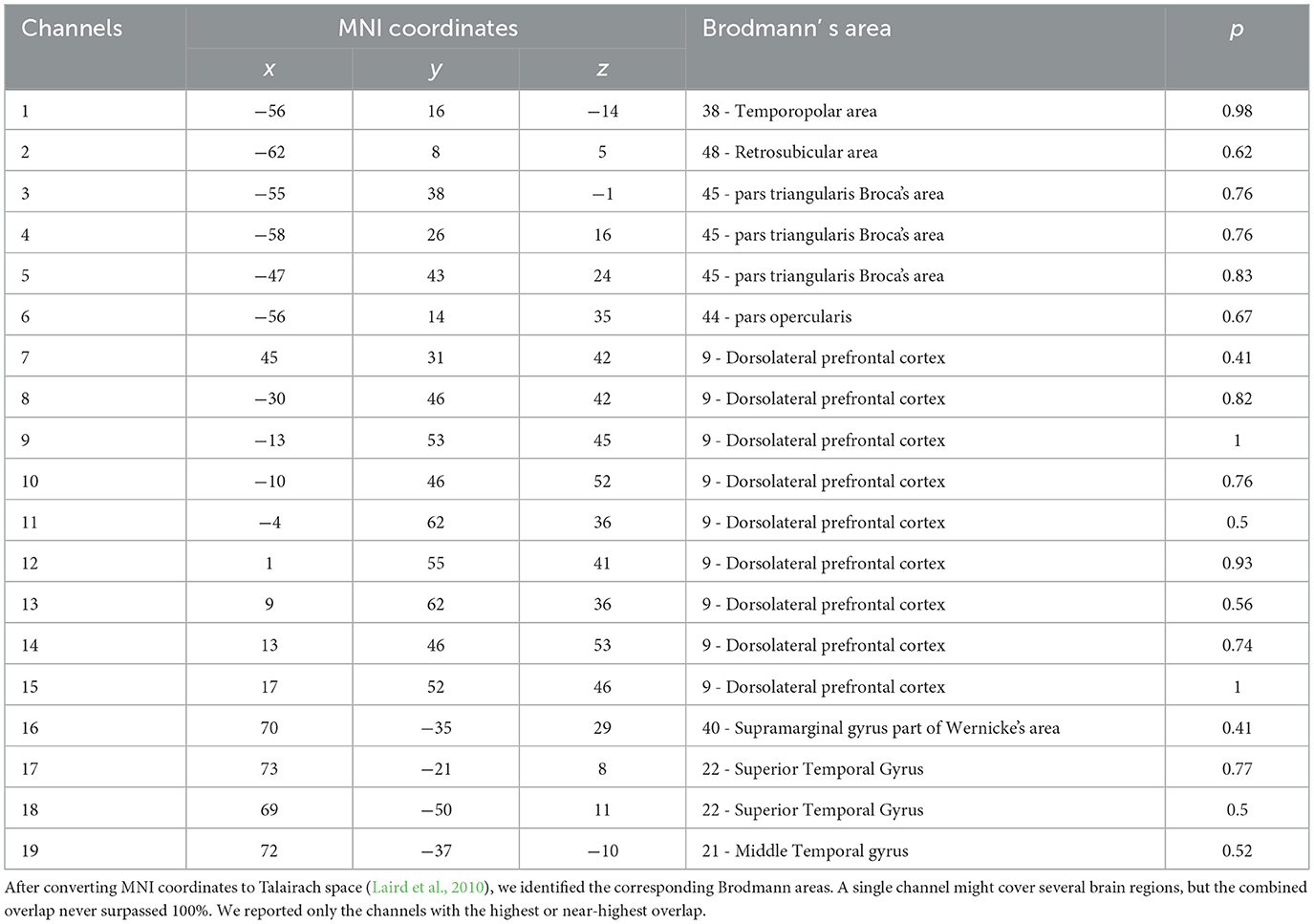- 1School of Psychology, Inner Mongolia Normal University, Hohhot, China
- 2School of Arts and Education, Chizhou University, Chizhou, China
- 3School of Psychology, Shanghai Normal University, Shanghai, China
- 4School of Management, Tianjin University of Traditional Chinese Medicine, Tianjin, China
Interpersonal conflict is a core yet complicated part of social interaction, involving complex mental and emotional processes. However, the neural mechanisms underlying interpersonal conflict are still not fully understood. This study employed functional near-infrared spectroscopy (fNIRS) hyperscanning to explore the brain activity related to interpersonal conflict through both passive video viewing and active role-playing paradigms. The results revealed an unexpected activation pattern – brain activity was highest at rest, lower during conflict, and lowest during neutral interactions (i.e., rest > conflict > neutral) in all ROIs except the rTPJ during active role-playing. This indicates a cortical deactivation effect when people engage in social processing. Additionally, the study found that inter-brain synchronization (IBS) between the two participants' brains decreased significantly during conflict compared to non-conflict conditions. These findings provide neurocognitive evidence for disrupted interpersonal alignment during conflict and highlight potential intervention targets—such as perspective-taking and interpersonal attunement—for enhancing social functioning in challenging interactions.
1 Introduction
Interpersonal interactions are crucial to human social life, shaping various social relationships that greatly impact individuals' psychological and emotional health. However, maintaining these relationships naturally requires managing conflicts, which inevitably emerge from incompatible goals, differing interests, or conflicting values values (Donohue and Cai, 2014). Interpersonal conflict occurs when an individual's actions obstruct, interfere with, or adversely affect another person's goals or behaviors, thereby reducing mutual effectiveness and cohesion (Burton et al., 1972). Such conflictual interactions usually manifest through dynamic exchanges involving ongoing verbal and nonverbal communication, as well as mutual inferences about each other's intentions, emotions, and thoughts. Because of their widespread presence and significant impact, understanding the neurocognitive mechanisms behind interpersonal conflict is crucial not only for advancing theory but also for practical use in conflict resolution and psychological treatment (Flanagan et al., 2019).
Despite extensive psychological research on interpersonal conflict, current empirical methods face significant limitations. Many studies rely on retrospective self-report surveys or categorize incidents into broad types (e.g., task vs. relationship conflict; Wright et al., 2017; Hill et al., 2019). This approach is limited because it offers only a static, subjective snapshot of conflict intensity or type, rather than capturing the dynamic interaction as it happens. In fact, many existing conflict scales were developed years ago and have not adapted to the broader understanding of interpersonal conflict, which now encompasses a wider range of behaviors, thoughts, and emotions (DeBaylo and Michel, 2022). By reducing conflict to broad categories and overall intensity ratings, researchers risk overlooking the complex, immediate processes that define real conflicts. Interpersonal conflict is inherently dynamic and interactive, involving a series of actions and reactions between dependent parties (Au and Lam, 2017; Long et al., 2021). It has been described as “a dynamic process” where parties experience negative emotional responses to perceived disagreements and interference with their goals (Barki and Hartwick, 2004; Ejbye-Ernst et al., 2022). However, typical empirical methods rarely observe these live dynamics. Hyperscanning provides such a framework by enabling the simultaneous measurement of neural activity in interacting partners (Balconi and Vanutelli, 2017; Nam et al., 2020).
An expanding body of hyperscanning research has demonstrated notable inter-brain synchronization (IBS) during cooperative interactions, indicating shared cognitive states and emotional alignment among participants (Liu et al., 2017; Balconi et al., 2021). While increased IBS during cooperation has been interpreted as a neural marker of shared intentionality and mutual understanding, it remains unclear whether and how such coupling deteriorates when interactions become adversarial. Besides, the neural synchronization patterns that occur during conflictual interactions are relatively underexplored, which limits our understanding of how neural coupling may fundamentally differ when interpersonal interactions shift from cooperative to adversarial contexts (Long et al., 2021; Ryu and Kim, 2024). Among available hyperscanning modalities, functional near-infrared spectroscopy (fNIRS) offers a unique balance between ecological validity and neural specificity. Although it provides lower temporal resolution than electroencephalography (EEG) and reduced spatial resolution compared to functional magnetic resonance imaging (fMRI) (Cui et al., 2011; Chiarelli et al., 2017), fNIRS enables participants to engage in naturalistic face-to-face interactions with minimal physical constraints—an essential feature for capturing the dynamics of interpersonal conflict.
Recent findings from hyperscanning studies indicate a decrease in IBS during contexts involving interpersonal conflict. This decline may be due to disruptions in shared attentional states and individual emotional regulation processes. For example, Liang et al. observed reduced IBS during tasks involving interpersonal conflict compared to resting states (Liang et al., 2022), especially in brain regions related to emotion regulation and social cognition, such as the dorsolateral prefrontal cortex (DLPFC), inferior frontal gyrus (IFG), and temporoparietal junction (TPJ). These decreases may reflect a shift toward self-focused cognitive and emotional processing, which reduces the neural coupling usually seen during active social interactions. Similarly, Hirsch and colleagues found that scenarios involving disagreement were also linked to lower IBS compared to agreement scenarios, further supporting the idea that divergent perspectives interfere with shared cognitive states and decrease inter-brain coupling (Hirsch et al., 2021). However, further replication and detailed investigation of this phenomenon across different task paradigms are necessary.
Employing multiple paradigms allows for a more thorough exploration of the psychological and neural processes involved in interpersonal conflict. The video-viewing paradigm provides a highly controlled form of experimental stimulus. All participants view the same standardized conflict scenes, which minimizes extraneous variability caused by stimulus differences and improves the comparability and reproducibility of results (Ryu and Kim, 2024). Conversely, the role-playing paradigm emphasizes ecological validity by involving participants in face-to-face scripted conflict interactions (Redcay and Schilbach, 2019). This dyadic, interactive approach more closely resembles real-life social exchanges and elicits spontaneous emotional and behavioral reactions. Participants must actively engage in verbal and nonverbal communication, demanding more intensive cognitive and emotional effort. This engagement enables researchers to observe dynamic processes such as emotion regulation and interpersonal synchrony. By using both paradigms, the current study can determine whether IBS and emotional responses differ depending on whether individuals are observing or participating in conflict, thus increasing the generalizability of the findings (Guo et al., 2022). Additionally, this dual-paradigm design balances internal validity and ecological validity: the video paradigm offers consistent, tightly controlled stimuli, while the role-play paradigm enhances the real-world relevance of the results.
The current study focused on four main brain regions that are key to emotional regulation, cognitive control, and social cognition: the left IFG (lIFG), bilateral DLPFC (lDLPFC, rDLPFC), and the right TPJ (rTPJ). The IFG and DLPFC are essential areas involved in managing emotions and exercising cognitive control, with strong evidence showing their roles in influencing affective responses and exerting inhibitory control during emotionally intense social interactions(Gross, 2015). The rTPJ has consistently been associated with social cognitive functions such as perspective-taking and mental state attribution (Frith et al., 2006). As a result, disruptions in shared attention or impaired perspective-taking, which are common in conflict situations, are expected to lead to decreased IBS within these critical regions. Ultimately, this study aims to deepen a comprehensive and detailed understanding of the neural and psychological dynamics of interpersonal conflict by integrating multiple paradigms. Based on limited prior research and social neuroscience frameworks (Zaki and Ochsner, 2012), we hypothesize that interpersonal conflict will reliably cause reduced IBS compared to neutral and resting conditions, indicating diminished shared emotional attunement.
2 Experiment 1: passive interpersonal conflict paradigm
2.1 Materials and methods
2.1.1 Participants
A total of 106 right-handed undergraduate students (22 males and 84 females), aged between 18 and 21 years (M = 19.54, SD = 1.79), participated in the experiment. Participants were randomly assigned to 53 same-gender dyads, with each pair consisting of individuals who were acquaintances. All participants possessed normal or corrected-to-normal vision and had no history of neurological or psychiatric disorders. The sample size of N = 28 was determined through a power analysis conducted using G*Power 3.1, with an α level of 0.05 and a power of 0.8 to detect a medium effect size (f = 0.25). This power analysis was consistently applied across all experiments reported in this article. Before participating, each individual provided written informed consent. Upon completing the experiment, participants received a show-up fee of 15 yuan. This study was approved by the Research Ethics Board of the School of Arts and Education at Chizhou University (Approval No. 2022030302) and was conducted in accordance with the Declaration of Helsinki.
2.1.2 Experimental tasks and procedure
Four standardized videos were produced, each featuring two actors participating in scripted dialogues. These included three scenarios showing interpersonal conflict and one neutral control scenario, with each video lasting 60 secs. Gender-matched dyads were assigned to watch matching videos (e.g., female–female dyads viewed videos with two female actors). The videos were shot in a controlled laboratory setting to ensure uniform context, and the actors rehearsed their scripts thoroughly to keep performance quality consistent.
Participants sat next to each other, facing a screen. After placing the fNIRS cap and locating the optodes, the session started with a 120 sec rest period. The dyads then watched three conflict-related videos, shown in a random order. Next, participants swapped roles and viewed the same scenarios again, but in a different random order. A neutral video was shown twice in a row afterward. Each video was preceded by a 30 sec rest to allow hemodynamic signals to reset to baseline. This process resulted in eight viewing trials per dyad: six conflict trials and two neutral trials. The full experimental procedure is shown in Figure 1A.

Figure 1. Experimental design. (A) Experimental 1 procedure and entire timeline; (B) Experimental 2 procedure and entire timeline.
Before the video task, participants completed a series of affective and social evaluation measures to determine if the conflict videos successfully evoked the intended emotional and social responses, serving as a validity check for the conflict paradigm: (1) perceived partner adorableness (rated on a 9-point scale, 1 = extremely unadorable, 9 = extremely adorable), (2) current mood valence (1 = extremely unhappy, 9 = extremely happy), and (3) the intended allocation of a ¥100 participation reward to their partner (range: ¥1–¥100). The same measures were taken after the task to assess changes in affective state and social perception. Additionally, participants evaluated (4) how much they identified with the assigned role during video viewing (1 = not at all, 9 = completely), and (5) the perceived congruence between the two characters' behavioral goals (1 = extremely incongruent, 9 = completely congruent).
2.2 fNIRS data acquisition
The fNIRS data were collected using the NIRSport2 system (NIRx Medical Technologies) at a sampling rate of 7.8125 Hz, with wavelengths of 760 nm and 850 nm. Data collection involved 19 channels with eight emitters and eight detectors, arranged in 6 × 6 and 2 × 2 arrays with an inter-optode distance of 30 mm. Optode placement followed the international 10–20 system, with the central column aligned along the sagittal plane and the lowest row along the axial plane. Anatomical locations were digitally registered using a Polhemus Fastrak 3D Digitizer, and the coordinates were later transformed to Montreal Neurological Institute (MNI) space using the NIRS_SPM MATLAB package (Table 1). The analysis of channels 1 and 2 is temporarily excluded due to their anatomical location. The remaining 17 channels were grouped into four brain regions of interest (ROIs): lDLPFC, rDLPFC, lIFG, and rTPJ (Figure 2).
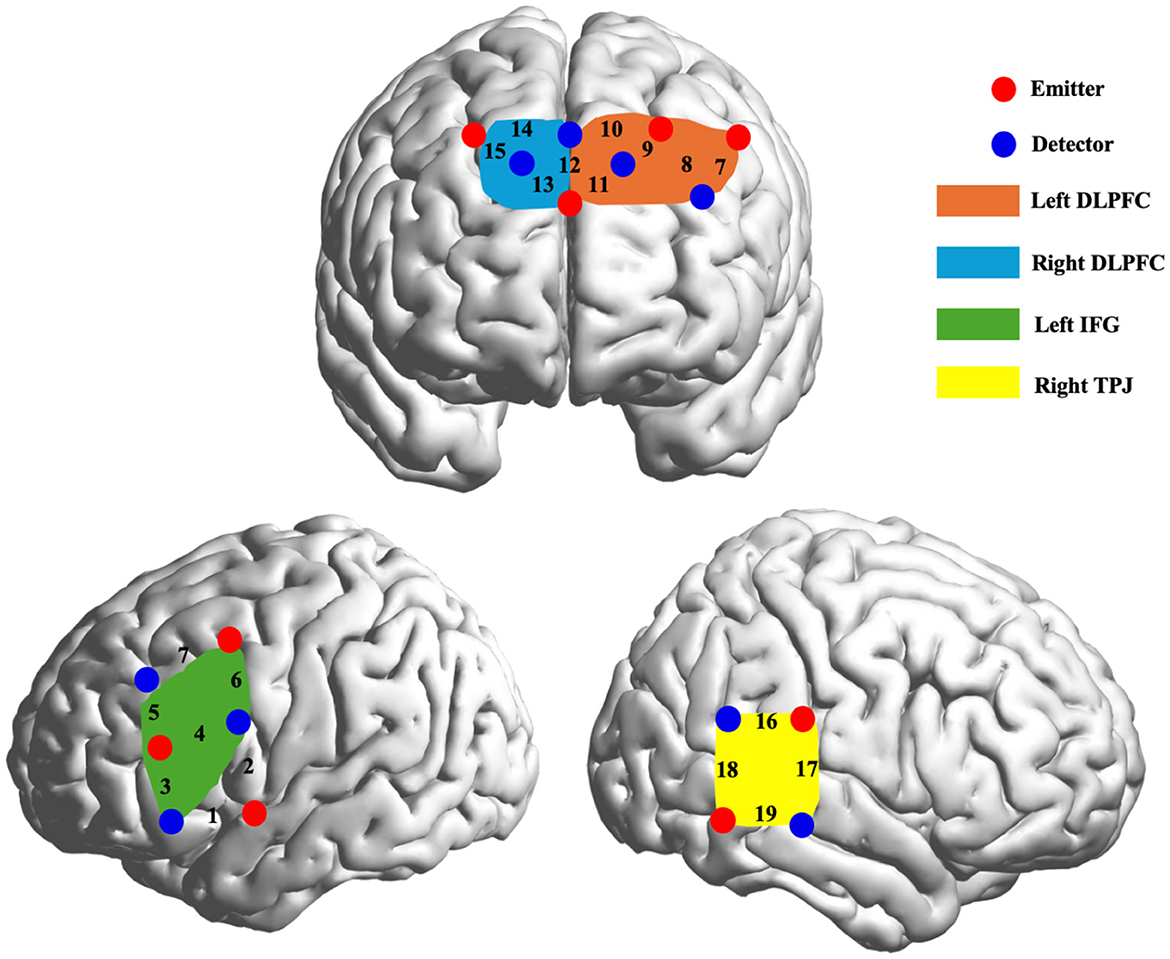
Figure 2. Optode probe set and channel layout. The number refers to the channel number and indicates its position. The ROI grouping was as follows: (1) Left inferior frontal gyrus (IFG): channels 3, 4, 5 and 6; (2) Left Dorsolateral Prefrontal Cortex (DLPFC): channels 7, 8, 9, 10 and 11; (3) Right DLPFC: channel 12, 13, 14, 15; (4) Right temporoparietal junction area (TPJ): channels 16, 17, 18 and 19.
2.3 Data analysis
The fNIRS data were collected using the NIRSport2 system (NIRx Medical Technologies) at a sampling rate of 7.8125 Hz, with wavelengths of 760 nm and 850 nm. Data collection involved 19 channels. Participant-level preprocessing was performed following established hyperscanning methods. The raw fNIRS data for each participant were processed with the HOMER2 MATLAB package (Huppert et al., 2009). First, the quality of the fNIRS signals was evaluated using the enPruneChannels function. Channels with a coefficient of variation (CV) greater than 15% were considered unreliable and excluded. If more than 50% of the channels were classified as unreliable, the data for the entire dyad were excluded from further analysis. However, based on these criteria, no dyads were excluded in this study. The raw fNIRS data were then transformed into optical density (OD) data using the hmrIntensity2OD function. Motion artifacts within the OD data were detected using the hmrMotionArtifactByChannel function, with parameters set to tMotion = 0.5, tMask = 3, STDEVthresh = 10, and AMPthresh = 50. These artifacts were later corrected using the wavelet-based motion artifact removal method via the hmrMotionCorrectWavelet function. The bandpass filtering was applied with the hmrBandpassFilt function, with high-pass and low-pass filter cutoffs set at 0.01 and 0.07, respectively. Finally, using the modified Beer–Lambert law, the OD data were transformed into concentrations of oxyhemoglobin (HbO) and deoxyhemoglobin (HbR) via the hmrOD2Conc function. Due to the high signal-to-noise ratio of the HbO signal, our analysis in this study focused solely on the HbO signal (Cui et al., 2012).
Intra-brain activation was examined at the individual level. For each ROI, the HbO values of the channels corresponding to the specific ROI, based on their anatomical locations, were averaged for each participant. After a Fisher z-transformation, a series of one-way repeated measures ANOVAs was performed on the ROI data across different experimental conditions. To control for multiple comparisons, a false discovery rate (FDR) correction was applied, with a significance threshold of p < 0.05.
The IBS at the dyadic level was analyzed by measuring the synchronization between participants' HbO time series within each dyad using the wavelet transform coherence (WTC) MATLAB package (Grinsted et al., 2004). This method was chosen to assess the temporal relationship of HbO signals between pairs of participants, a technique widely used in previous research (Cui et al., 2012; Zhang et al., 2021a). Next, a data-driven frequency-band selection approach was applied to compare wavelet coherence values across two task conditions and a resting phase (Zhang et al., 2021b). For each condition, WTC was calculated across all frequency bands to determine the average coherence during the task. Then, one-way repeated measures ANOVAs were performed on these average WTC values across the two task conditions and resting phase to identify a statistically significant frequency band (0.01–0.05 Hz, Figure 3). This frequency band was chosen to exclude high-frequency and low-frequency noise, such as physiological signals related to blood pressure (about 0.1 Hz), respiration (about 0.2–0.3 Hz), and heart rate (1 Hz) (Nozawa et al., 2016; Zhang et al., 2020). The IBS within this selected frequency band was then averaged across conditions (Zhao et al., 2023). Following this, the IBS for each pair of channels within a specific ROI was averaged, and WTC values were computed and transformed using Fisher z-statistics (Chang and Glover, 2010). Additional one-way repeated measures ANOVAs were conducted on the task-related IBS across all frequencies of interest (FOIs) and ROIs, with condition (conflict, neutral, resting) as the within-participant factor. An FDR correction was also applied. Visualization was performed using the BrainNet Viewer MATLAB package (Xia et al., 2013).
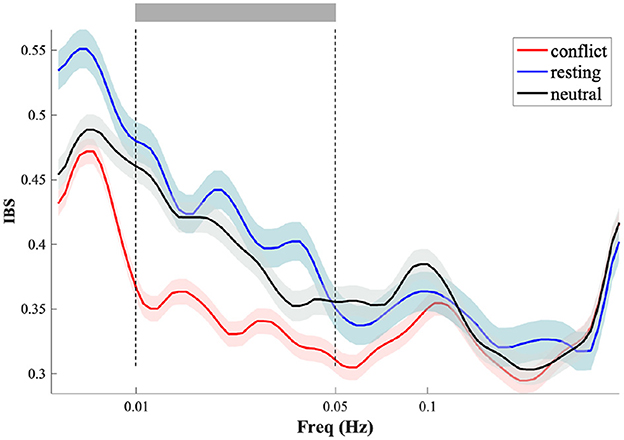
Figure 3. IBS Variations when identifying the frequency band of interest. Significant frequency from 0.01 to 0.05Hz (20–100s) under Experiment 1. The interval delineated by two vertical dashed lines shows the significant frequency range.
2.4 Results
2.4.1 Affective and social evaluations
To evaluate the effect of the conflict videos on participants' social and emotional assessments, paired-sample t-tests were performed comparing scores before and after viewing. Change scores (MD) were calculated as the mean before viewing minus the mean after viewing. Perceived partner adorableness significantly decreased following the video task, MD ± SE = 0.86 ± 0.18, t (105) = 4.83, p < 0.001, Cohen's d = 0.47. Self-reported happiness also significantly declined, MD ± SE = 0.85 ± 0.17, t (105) = 4.93, p < 0.001, Cohen's d = 0.48. The amount of reward given to the partner also significantly decreased, MD ± SE = 2.99 ± 1.39, t (105) = 2.16, p =0.03, Cohen's d = 0.21. To examine participants' engagement with the video task, one-sample t-tests were conducted comparing the average ratings to the scale midpoint (expected value = 5). Participants reported high engagement when viewing neutral videos, M = 6.10, t (105) = 7.99, p < 0.001, Cohen's d = 0.77. They also demonstrated moderate engagement with conflict videos (M = 5.51, t(105) = 3.61, p < 0.001, Cohen's d = 0.35) and perceived low goal congruence between the characters in the conflict videos (M = 3.21, t (106) = −15.96, p < 0.001, Cohen's d = 1.54).
2.4.2 Intra-brain activation
Significant differences appeared in intra-brain HbO across conditions in all ROIs (lIFG: F (2, 210) = 80.828, FDR-corrected p < 0.001, = 0.435; lDLPFC: F (2, 210) = 143.312, FDR-corrected p < 0.001, = 0.577; rDLPFC: F (2, 210) = 112.502, FDR-corrected p < 0.001, = 0.517; and rTPJ: F (2, 210) = 97.374, FDR-corrected p < 0.001, = 0.481; Figure 4). Critically, resting periods exhibited positive HbO activation, while both conflict and neutral conditions had negative HbO responses (deactivations). Post-hoc tests revealed higher HbO during resting compared to conflict conditions, with conflict conditions exceeding neutral conditions (Figure 5A).
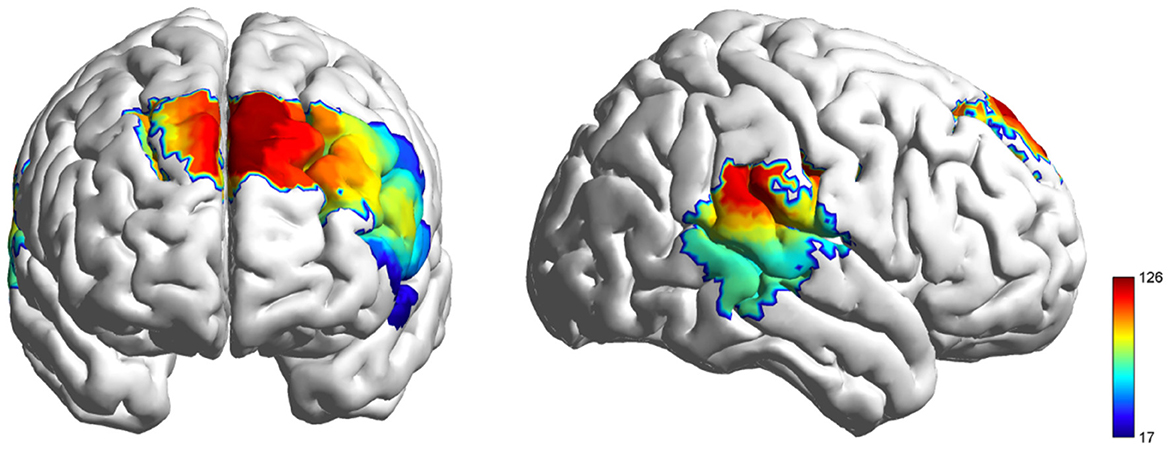
Figure 4. HbO activation F-test maps generated from individual fNIRS channels, illustrating cortical hemodynamic responses during the video viewing.

Figure 5. Results of the Analysis. (A) Differences in the level of brain activation of all ROIs. (B) Differences in IBS of all ROIs. The error bars represent the standard deviation (SD). *p <0.05.**p <0.01.***p <0.001.
2.4.3 Inter-brain coupling
For IBS, significant differences between conditions were observed in lIFG: F (2, 104) = 6.968, FDR-corrected p < 0.01, = 0.118; lDLPFC: F (2, 104) = 6.716, FDR-corrected p < 0.01, = 0.118; rDLPFC: F (2, 104) = 5.767, FDR-corrected p < 0.01, = 0.100; and rTPJ: F (2, 104) = 9.688, FDR-corrected p < 0.001, = 0.157 (Figure 6). Subsequent post-hoc tests revealed that IBS significantly decreased during conflict compared to neutral and resting conditions in lIFG, rDLPFC, and rTPJ; however, the reduction in IBS in rDLPFC during conflict vs. neutral conditions was not significant (Figure 5B).
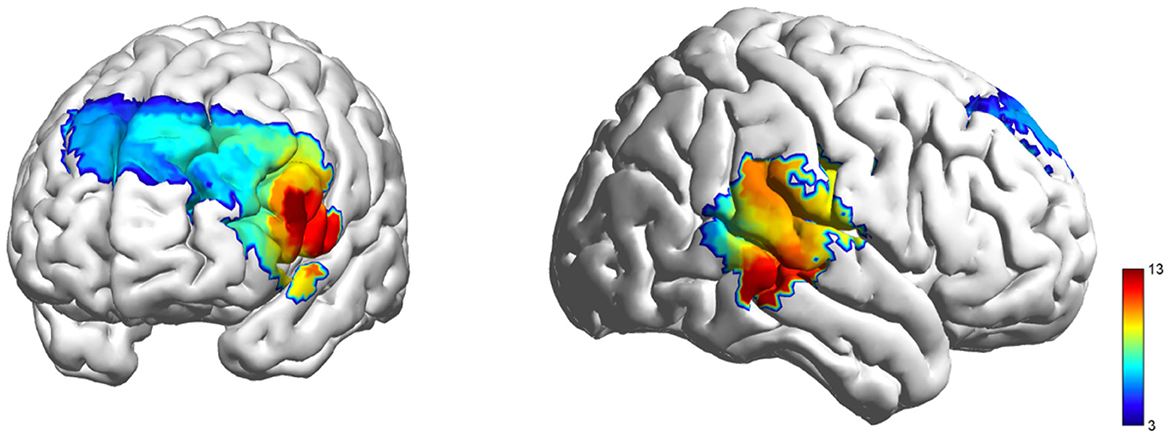
Figure 6. Coherence F-test maps generated from the dyad's fNIRS channels, illustrating inter-brain synchronization during the video viewing.
3 Experiment 2: active interpersonal conflict paradigm
To assess how well the inter-brain synchronization patterns found in Experiment 1 could apply to situations with active participation, Experiment 2 used a role-playing setup. In this setup, participants performed scripted scenarios involving interpersonal conflicts and neutral conversations.
3.1 Participants and procedure
Fifty-eight right-handed undergraduates (10 males, 48 females; age range: 18–21 years, M = 19.72, SD = 1.67) formed 29 same-gender acquainted dyads. The procedures for consent and ethical approval were the same as in Experiment 1 (Figure 1B).
In Experiment 2, a structured role-playing format was used, consisting of three conflict scenarios and one neutral interaction. Participants were asked to memorize and perform scripts that matched their gender, actively engaging in both dialogues and gestures. The procedure was similar to that of Experiment 1, beginning with an initial rest period, followed by randomized enactments of conflict scenarios, role reversals with repeated performances, and subsequent neutral interactions. Each session was broken up by 30 sec rest periods, ending with a total of eight dialogues (six conflict and two neutral). As in Experiment 1, participants completed the same affective and social evaluation measures before and after the task. In addition, the configuration of the fNIRS, the placement of optodes, and the analytical protocols—including preprocessing, HbO activity calculation, IBS calculation, frequency selection, and statistical analysis—were replicated exactly from Experiment 1, thereby ensuring methodological consistency across the experiments.
3.2 Results
3.2.1 Affective and social evaluations
Perceived partner adorableness significantly declined after the role-playing task, t (57) = 6.09, p < 0.01, Cohen's d = 0.77. Self-reported happiness also saw a significant drop, t (57) = 6.01, p < 0.01, Cohen's d = 0.76. The amount of reward given to the partner significantly decreased as well, t (57) = 5.29, p < 0.01, Cohen's d = 0.67. Participants reported high engagement with their assigned roles, M = 6.94, t (57) = 11.26, p < 0.01, Cohen's d = 1.43. They perceived low goal congruence between the two characters in the conflict scenarios they role-played, M = 3.15, t (57) = −12.94, p < 0.01, Cohen's d = 1.64.
3.2.2 Intra-brain activation
ROI-specific HbO differences across conditions were significant (lIFG: F (2, 114) = 31.011, FDR-corrected p < 0.001, = 0.352; lDLPFC: F (2, 114) = 49.767, FDR-corrected p < 0.001, = 0.466; rDLPFC: F (2, 114) = 49.667, FDR-corrected p < 0.001, = 0.466; and rTPJ: F (2, 114) = 43.007, FDR-corrected p < 0.001, = 0.430; Figure 7). In contrast to the findings of Experiment 1, the conflict condition demonstrated positive HbO activation in rTPJ, and the observed differences between the rest and conflict conditions did not achieve statistical significance. Apart from this, the results in other brain regions were consistent with those of Experiment 1 (Figure 8A).
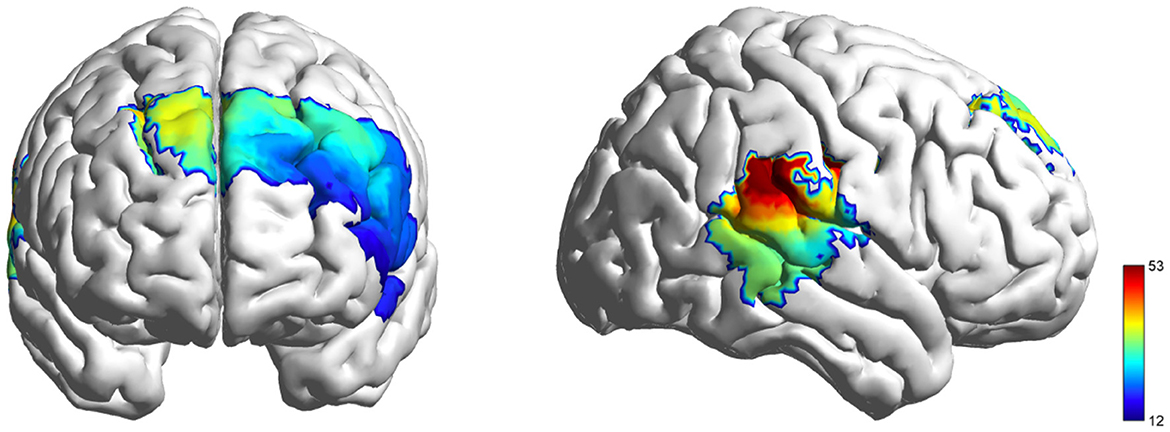
Figure 7. HbO activation F-test maps generated from individual fNIRS channels, illustrating cortical hemodynamic responses during the role playing.
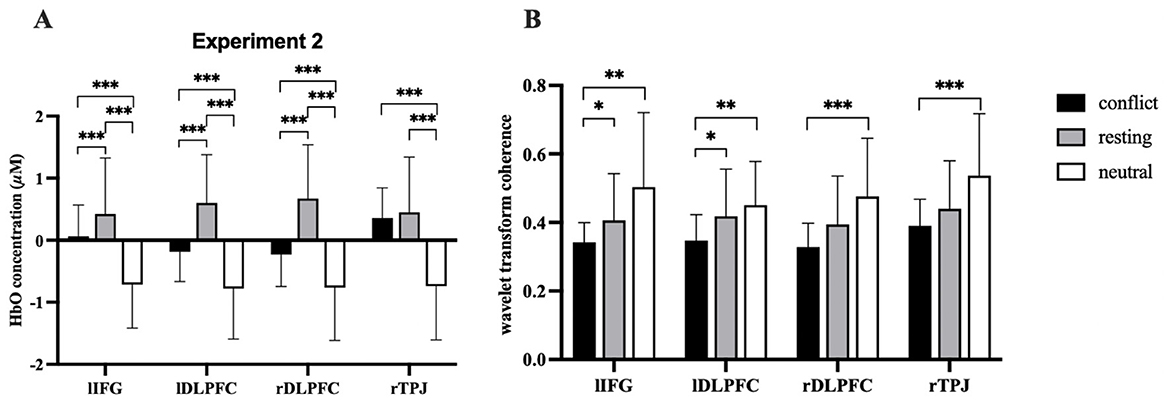
Figure 8. Results of the Analysis. (A) Differences in the level of brain activation of all ROIs during role-playing. (B) Differences in IBS across all ROIs during role-playing. The error bars represent the standard deviation (SD). *p < 0.05,**p < 0.01,***p < 0.001 indicate levels of statistical significance.
3.2.3 Inter-brain coupling
IBS condition effects were significant for lIFG: F (2, 56) = 7.318, FDR-corrected p < 0.01, = 0.207; lDLPFC: F (2, 56) = 8.313, FDR-corrected p < 0.01, = 0.229; rDLPFC: F (2, 56) = 8.345, FDR-corrected p < 0.01, = 0.230; and rTPJ: F (2, 56) = 9.879, FDR-corrected p < 0.001, = 0.261 (Figure 9). Subsequent post-hoc analyses indicated that within the lIFG and lDLPFC, the IBS showed a significant decrease when viewing conflict videos compared to both neutral videos and the resting phase. Conversely, in the rDLPFC and rTPJ, IBS during conflict video viewing was significantly reduced compared to neutral video viewing, yet it did not differ considerably from the resting phase (Figure 8B).
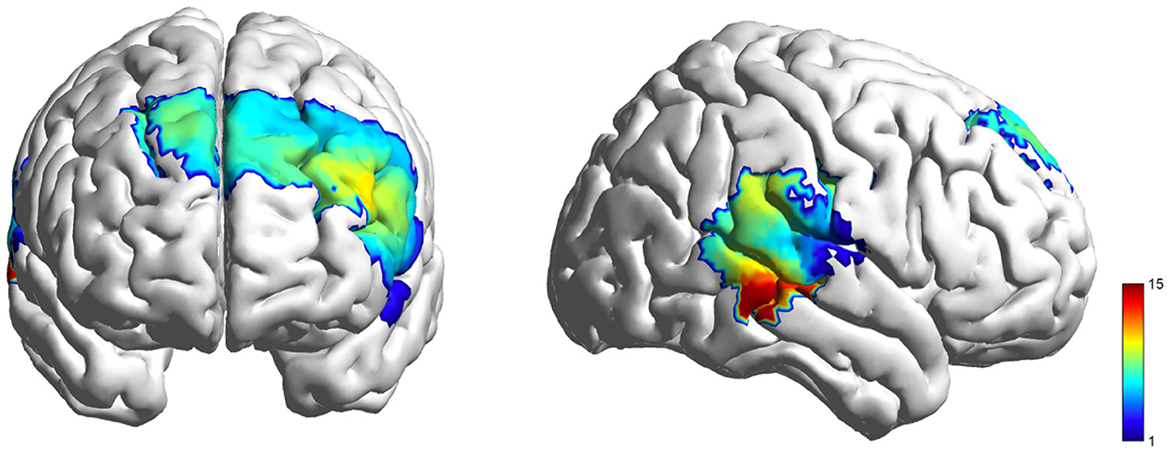
Figure 9. Coherence F-test maps generated for the dyad's fNIRS channels, illustrating inter-brain synchronization during the role playing.
4 Discussion
This study aimed to explore how the brain functions during interpersonal conflict by using fNIRS hyperscanning during passive observation and active role-playing. It compared brain activation and inter-brain synchronization patterns. Results showed a unique activation pattern: brain activity increased above baseline during rest, while both conflict and neutral situations caused deactivation compared to rest, with neutral conditions showing even more deactivation than conflict (rest > conflict > neutral). Notably, the rTPJ was different from this pattern during active role-playing, showing a tendency toward positive activation in conflict scenarios. This suggests brain deactivation during social interaction. Additionally, IBS significantly dropped during conflict compared to non-conflict situations, indicating that neural coordination between partners was reduced during conflict. In simple terms, during conflict, the two brains were less “in tune” with each other than when they interacted calmly.
Firstly, the positive activation of the brain during rest likely reflects its involvement in self-generated cognitive activity and internal monitoring processes (Meyer and Lieberman, 2018; Schneider et al., 2008). Both DLPFC and lIFG are key components of the executive control system, which remains active at baseline to support internal cognitive organization and maintain readiness for external demands. This form of “default activation” has been well documented in both fNIRS and fMRI research, showing higher prefrontal oxygenation and metabolism during rest compared to low-demand or passive conditions (Mars et al., 2012; Matsuda and Hiraki, 2006; Xie et al., 2024). Such increased resting activity has been interpreted as reflecting a preparatory or readiness function in previous studies, although our data do not directly test this assumption. The observed activation pattern (rest > conflict > neutral) suggests that engaging in tasks—whether conflictual or neutral—leads to cortical deactivation in the DLPFC and lIFG relative to rest (Koshino et al., 2023; Menon, 2023). When individuals shift to social or externally focused interactions, these prefrontal regions decrease activity, reflecting a switch from internally focused self-regulation to externally directed attention (Raichle et al., 2001; Buckner et al., 2008). For example, fNIRS studies show decreased activation in the anterior left PFC during role-playing tasks, indicating less engagement of self-referential and introspective networks when individuals adopt another's perspective or perform socially embedded behaviors (Lim et al., 2024b).
Furthermore, our analyses showed a distinctive activation profile marked by greater cortical deactivation during the neutral condition compared to the conflict condition. This finding aligns with those of Matsukawa and colleagues, who reported that the PFC showed a significant decrease in activation during neutral video viewing, indicating a broad pattern of deactivation. Conversely, viewing emotionally arousing clips, such as horror scenes (negative emotion), caused only minimal changes — that is, a mild or nonsignificant decrease. In other words, the neutral viewing condition triggered more prefrontal deactivation than the more arousing conflict or threat conditions (Matsukawa et al., 2018). This pattern might be related to the dynamic balance between the default mode network (DMN) and task-positive networks. Since the brain's networks operate in a push-pull manner, when the DMN is active during neutral or routine social engagement, the task-positive network (including DLPFC/IFG) tends to deactivate (Mancuso et al., 2022; Menon, 2023; Raichle et al., 2001). In contrast, conflict situations require sustained cognitive regulation and suppression of the DMN, leading to reduced deactivation in the DLPFC and IFG (Wittfoth et al., 2009).
During the active role-playing task in the present study, a similar distinction between the conflict and neutral conditions was also observed in the DLPFC and IFG. Overall, well-practiced neutral interactions, like polite role-playing, may suppress DLPFC and IFG activity below their default levels, as individuals rely on automated social scripts rather than effortful control (Weissman et al., 2008). Conversely, conflict scenarios likely engage additional social-cognitive processes—such as perspective-taking, mentalizing about others' intentions, or emotional appraisal—which can counteract the typical task-based deactivation. In fact, evidence shows that brain regions in the DMN can exhibit less suppression or even positive activation during emotionally charged or social tasks (Di Plinio et al., 2018). Although our study did not directly assess DMN activity, the observed pattern is consistent with prior findings suggesting that emotionally or socially demanding situations may maintain higher DMN engagement. Therefore, conflict trials did not suppress the “default” network as much, aligning with the observed pattern (Jack et al., 2013).
Interestingly, the rTPJ deviated from this general deactivation pattern, showing a weak trend toward positive activation during conflict in the active role-playing condition. The rTPJ is a key hub for mentalizing and perspective-taking—the ability to infer others' intentions and beliefs (Saxe et al., 2004; Schurz et al., 2014). For example, disrupting the rTPJ impairs one's ability to handle conflicting viewpoints and moral dilemmas, indicating its essential role in conflict resolution and theory-of-mind processes (Buckner et al., 2008; Qureshi et al., 2020; Schilbach et al., 2013). Its selective activation suggests that, although conflict generally reduces shared neural processing, it still activates localized social-cognitive mechanisms. In emotionally charged or competitive situations, individuals may try to interpret their partner's intentions or predict responses, temporarily engaging the rTPJ (Decety and Lamm, 2007). Consistent with previous hyperscanning studies, disagreement or conflicting goals often increase activity in the rTPJ and nearby temporal-parietal areas, indicating heightened perspective-taking despite overall cortical downregulation (Redcay and Schilbach, 2019). The divergence in rTPJ activity may indicate that interpersonal conflict engages perspective-processing networks more strongly than neutral interactions.
Crucially, our findings showed a significant decrease in IBS during interpersonal conflict compared to control conditions. IBS usually occurs when people constantly predict and adjust to each other's behavior in real time. During positive or cooperative interactions, partners make continuous mutual predictions—such as finishing each other's sentences or expecting each other's actions—which enhances neural coupling (Hoehl et al., 2021). In fact, when two individuals intentionally try to predict each other's movements or responses, their brains show greater synchrony (Kayhan et al., 2022; Zhang et al., 2024). Conversely, during interpersonal conflict, this predictive coordination breaks down. Conflictual conversations are often disjointed: people interrupt, talk over one another, or respond unexpectedly. This unpredictability—sometimes intentional, like offering an unanticipated rebuttal—disrupts the timing that would normally maintain neural alignment (Léné et al., 2021).
Furthermore, conflict often triggers different attention patterns and individual regulatory processes, such as self-directed emotion regulation and defensive cognitive strategies. In these moments, individuals tend to focus inward on managing their internal states—like forming counterarguments, suppressing impulses, or controlling negative feelings—rather than paying attention to their partner's cues (Morawetz et al., 2017). This inward focus and reliance on self-regulation weaken the shared mental models and joint attention frameworks that support neural synchronization. As a result, IBS decreases as social partners disengage from reciprocal prediction and co-regulation, indicating a breakdown in the dynamic connection of their cognitive and emotional systems (Hirsch et al., 2021; Liang et al., 2022). Therefore, lower inter-brain coupling during conflicts can be seen as a neural sign of the disconnection between interacting minds. Reduced synchrony in key social-cognitive and regulatory areas may show a shift from cooperative, mutually engaged processing to more isolated, self-focused thoughts and feelings—patterns that reflect interpersonal disagreement (Long et al., 2021). Additionally, the heightened emotional arousal and negative feelings typical of conflict increase the demand for internal emotion regulation and cognitive resources, making intrapersonal neural synchrony more prominent than interpersonal synchrony. This inward turn in cognitive–affective processing interrupts the neural mirroring and dynamic coupling usually seen during cooperative or emotionally tuned interactions (Balconi and Vanutelli, 2017).
Finally, it's also crucial to consider how conflict is induced—whether passively (by observing conflict) or actively (by engaging in conflict)—as this can influence the pattern of IBS changes. In passive viewing scenarios, two individuals might simultaneously watch a scene of interpersonal conflict, such as a video of a heated argument, vs. a non-conflict scene (Froese et al., 2024). Even though they are not arguing with each other, conflict content can still decrease the synchronicity of their brain responses compared to neutral content. This occurs because each viewer's personal reactions to the conflict may differ—one might empathize with a particular character or feel anxious, while the other remains detached or takes the opposite side. Their emotional and cognitive responses to the same video thus diverge, resulting in lower inter-brain coherence. In active role-playing or real interpersonal conflict, the effects on IBS can be deeper and more complex (Markus and Shamay-Tsoory, 2024). Here, the individuals are not just spectators; they are participants in the conflict. Active conflicts are likely to trigger stronger emotional and strategic engagement, which could contribute to the observed IBS patterns.
5 Limitations and implications
The present study recognizes several limitations that should be addressed in future research. First, the experimental design employed passive video-viewing and scripted role-playing paradigms to study interpersonal conflict. While these methods provided good experimental control, they may not fully capture the complexity, spontaneity, and dynamic interactions typical of naturally occurring interpersonal conflicts. Future research should include more ecologically valid interactive tasks, such as real-time, unscripted conflict interactions, to better reflect authentic social dynamics and reciprocal processes during conflict scenarios (Moffat et al., 2024). Second, in an effort to reduce potential gender-related confounds, this study only included same-gender dyads. However, the gender makeup of interacting individuals can significantly influence neural and behavioral responses during interpersonal conflict. Therefore, future studies should systematically include both same- and mixed-gender dyads to clarify the impact of gender interactions on neural synchronization and conflict processing (Lim et al., 2024a). Third, due to the technical limitations of the fNIRS method, our study was limited to a specific set of cortical regions. Although our chosen areas were theoretically justified, future research should aim for broader cortical coverage, including additional critical regions such as the medial prefrontal cortex and relevant subcortical structures. This expansion would enable a more comprehensive mapping of the neural networks involved in interpersonal conflict and deepen our understanding of the underlying cognitive and emotional mechanisms.
6 Conclusions
This study systematically explored the neural basis of interpersonal conflict by combining fNIRS hyperscanning with two different paradigms: passive video observation and active role-playing. The results showed an unexpected activation pattern—brain activity was highest at rest, lower during conflict, and lowest during neutral interactions. At the same time, conflict reduces neural synchronization between individuals, reflecting the loss of harmony in their interaction. These findings, supported by similar studies in social neuroscience, form a consistent picture: when people connect and cooperate, their brains synchronize and social networks activate; when they clash, that unity breaks down both behaviorally and neurally. Understanding this neural dynamic not only supports our intuitive feelings in conflict (such as feeling “out of sync”) but also could guide strategies for conflict resolution.
Data availability statement
The raw data supporting the conclusions of this article will be made available by the authors, without undue reservation.
Ethics statement
The studies involving humans were approved by Research Ethics Board of the School of Arts and Education, Chizhou University (Approval No. 2022030302). The studies were conducted in accordance with the local legislation and institutional requirements. The participants provided their written informed consent to participate in this study.
Author contributions
KC: Conceptualization, Funding acquisition, Investigation, Methodology, Writing – original draft. MZ: Conceptualization, Data curation, Formal analysis, Methodology, Writing – review & editing. YZ: Formal analysis, Visualization, Writing – original draft, Writing – review & editing. JL: Project administration, Supervision, Writing – review & editing.
Funding
The author(s) declare that financial support was received for the research and/or publication of this article. This research was funded by Humanities and Social Sciences Research Project Sponsored by the Anhui Provincial Department of Education (SK2021A0737).
Conflict of interest
The authors declare that the research was conducted in the absence of any commercial or financial relationships that could be construed as a potential conflict of interest.
Generative AI statement
The author(s) declare that no Gen AI was used in the creation of this manuscript.
Any alternative text (alt text) provided alongside figures in this article has been generated by Frontiers with the support of artificial intelligence and reasonable efforts have been made to ensure accuracy, including review by the authors wherever possible. If you identify any issues, please contact us.
Publisher's note
All claims expressed in this article are solely those of the authors and do not necessarily represent those of their affiliated organizations, or those of the publisher, the editors and the reviewers. Any product that may be evaluated in this article, or claim that may be made by its manufacturer, is not guaranteed or endorsed by the publisher.
References
Au, A. K. C., and Lam, S. (2017). Understanding response patterns in dyadic conflict: an interactive approach combining self-construal and opponent's dominance-submissiveness. Int. J. Psychol. 52, 116–125. doi: 10.1002/ijop.12193
Balconi, M., Angioletti, L., Balconi, M., Angioletti, L., Balconi, M., and Angioletti, L. (2021). Unravelling competitors' brain-andbody correlates. The two-persons social neuroscience approach to study competition. Neuropsychol. Trends 29, 83–104. doi: 10.7358/neur-2021-029-bal2
Balconi, M., and Vanutelli, M. E. (2017). Cooperation and competition with hyperscanning methods: review and future application to emotion domain. Front. Comput. Neurosci.. 11:00086. doi: 10.3389/fncom.2017.00086
Barki, H., and Hartwick, J. (2004). Conceptualizing the construct of interpersonal conflict. Int. J. Conf. Manage. 15, 216–244. doi: 10.1108/eb022913
Buckner, R. L., Andrews-Hanna, J. R., Schacter, D. L., Buckner, R. L., Andrews-Hanna, J. R., Schacter, D. L., et al. (2008). The brain's default network. Ann. N. Y. Acad. Sci. 1124, 1–38. doi: 10.1196/annals.1440.011
Burton, J. W., Burton, J. W., and Burton, J. W. (1972). Resolution of conflict. Int. Stud. Q. 16:5. doi: 10.2307/3013469
Chang, C., and Glover, G. H. (2010). Time–frequency dynamics of resting-state brain connectivity measured with fMRI. NeuroImage 50, 81–98. doi: 10.1016/j.neuroimage.2009.12.011
Chiarelli, A. M., Zappasodi, F., Di Pompeo, F., and Merla, A. (2017). Simultaneous functional near-infrared spectroscopy and electroencephalography for monitoring of human brain activity and oxygenation: a review. Neurophotonics 4:1. doi: 10.1117/1.NPh.4.4.041411
Cui, X., Bray, S., Bryant, D. M., Glover, G. H., and Reiss, A. L. (2011). A quantitative comparison of NIRS and fMRI across multiple cognitive tasks. NeuroImage 54, 2808–2821. doi: 10.1016/j.neuroimage.2010.10.069
Cui, X., Bryant, D. M., and Reiss, A. L. (2012). NIRS-based hyperscanning reveals increased interpersonal coherence in superior frontal cortex during cooperation. NeuroImage 59, 2430–2437. doi: 10.1016/j.neuroimage.2011.09.003
DeBaylo, P., and Michel, J. S. (2022). Identifying energy and emotion-based conflict: Development of a refined work-life conflict scale. Stress Health 38, 961–977. doi: 10.1002/smi.3148
Decety, J., and Lamm, C. (2007). The role of the right temporoparietal junction in social interaction: how low-level computational processes contribute to meta-cognition. Neuroscient. 13, 580–593. doi: 10.1177/1073858407304654
Di Plinio, S., Ferri, F., Marzetti, L., Romani, G. L., Northoff, G., and Pizzella, V. (2018). Functional connections between activated and deactivated brain regions mediate emotional interference during externally directed cognition. Hum. Brain Mapp. 39, 3597–3610. doi: 10.1002/hbm.24197
Donohue, W. A., and Cai, D. A. (2014). “Interpersonal conflict: an overview,” in Managing Interpersonal Conflict: Advances Through Meta-Analysis, eds. N. A. Burrell, M. Allen, B. M. Gayle, and R. W. Preiss (New York, NY: Routledge), 20–39.
Ejbye-Ernst, P., Lindegaard, M. R., Bernasco, W., Ejbye-Ernst, P., Lindegaard, M. R., Bernasco, W., et al. (2022). Third parties mirror the aggression of the antagonists: a video-based analysis of third-party aggression in interpersonal conflicts. J. Interpers. Viol. 37, NP15899–NP15924. doi: 10.1177/08862605211023503
Flanagan, J. C., Yonce, S., Calhoun, C. D., Back, S. E., Brady, K. T., and Joseph, J. E. (2019). Preliminary development of a neuroimaging paradigm to examine neural correlates of relationship conflict. Psychiatr. Res. Neuroimag. 283, 125–134. doi: 10.1016/j.pscychresns.2018.12.009
Frith, C. D., Frith, U., Frith, C. D., Frith, U., Frith, C. D., and Frith, U. (2006). The Neural basis of mentalizing. Neuron 50, 531–534. doi: 10.1016/j.neuron.2006.05.001
Froese, T., Loh, C. L., and Putri, F. (2024). Inter-brain desynchronization in social interaction: a consequence of subjective involvement? Front. Hum. Neurosci. 18:1359841. doi: 10.3389/fnhum.2024.1359841
Grinsted, A., Moore, J. C., and Jevrejeva, S. (2004). Application of the cross wavelet transform and wavelet coherence to geophysical time series. Nonlinear Process. Geophys. 11, 561–566. doi: 10.5194/npg-11-561-2004
Gross, J. J. (2015). Emotion regulation: current status and future prospects. Psychol. Inq. Int. J. Adv. Psychol. Theor. 26, 1-26. doi: 10.1080/1047840X.2014.940781
Guo, T., Wang, F., Cao, N., and Liu, H. (2022). Conflicts influence affects: an FMRI study of emotional effects in a conflict task. Cogn. Neurodyn. 16, 1261–1271. doi: 10.1007/s11571-022-09790-6
Hill, P. L., Schultz, L. H., Jackson, J. J., and Andrews, J. A. (2019). Parent-child conflict during elementary school as a longitudinal predictor of sense of purpose in emerging adulthood. J. Youth Adolesc. 48, 145–153. doi: 10.1007/s10964-018-0912-8
Hirsch, J., Tiede, M., Zhang, X., Noah, J. A., Salama-Manteau, A., and Biriotti, M. (2021). Interpersonal agreement and disagreement during face-to-face dialogue: an fNIRS investigation. Front. Hum. Neurosci. 14:606397. doi: 10.3389/fnhum.2020.606397
Hoehl, S., Fairhurst, M., and Schirmer, A. (2021). Interactional synchrony: signals, mechanisms and benefits. Soc. Cogn. Affect. Neurosci. 16, 5–18. doi: 10.1093/scan/nsaa024
Huppert, T. J., Diamond, S. G., Franceschini, M. A., and Boas, D. A. (2009). HomER: a review of time-series analysis methods for near-infrared spectroscopy of the brain. Appl. Opt. 48:D280. doi: 10.1364/AO.48.00D280
Jack, A. I., Dawson, A. J., Begany, K. L., Leckie, R. L., Barry, K. P., Ciccia, A. H., et al. (2013). fMRI reveals reciprocal inhibition between social and physical cognitive domains. NeuroImage 66, 385–401. doi: 10.1016/j.neuroimage.2012.10.061
Kayhan, E., Nguyen, T., Matthes, D., Langeloh, M., Michel, C., Jiang, J., et al. (2022). Interpersonal neural synchrony when predicting others' actions during a game of rock-paper-scissors. Sci. Rep. 12:12967. doi: 10.1038/s41598-022-16956-z
Koshino, H., Osaka, M., Shimokawa, T., Kaneda, M., Taniguchi, S., Minamoto, T., et al. (2023). Cooperation and competition between the default mode network and frontal parietal network in the elderly. Front. Psychol. 14:1140399. doi: 10.3389/fpsyg.2023.1140399
Laird, A. R., Robinson, J. L., McMillan, K. M., Tordesillas-Gutiérrez, D., Moran, S. T., Gonzales, S. M., et al. (2010). Comparison of the disparity between Talairach and MNI coordinates in functional neuroimaging data: validation of the Lancaster transform. Neuroimage 51, 677–683. doi: 10.1016/j.neuroimage.2010.02.048
Léné, P., Karran, A. J., Labonté-Lemoyne, E., Sénécal, S., Fredette, M., Johnson, K. J., et al. (2021). Is there collaboration specific neurophysiological activation during collaborative task activity? An analysis of brain responses using electroencephalography and hyperscanning. Brain Behav. 11:e2270. doi: 10.1002/brb3.2270
Liang, Z., Li, S., Zhou, S., Chen, S., Li, Y., Chen, Y., et al. (2022). Increased or decreased? Interpersonal neural synchronization in group creation. NeuroImage 260:119448. doi: 10.1016/j.neuroimage.2022.119448
Lim, M., Carollo, A., Bizzego, A., Chen, S. A., and Esposito, G. (2024a). Culture, sex and social context influence brain-to-brain synchrony: an fNIRS hyperscanning study. BMC Psychol. 12:350. doi: 10.1186/s40359-024-01841-3
Lim, M., Carollo, A., Bizzego, A., Chen, S. A., and Esposito, G. (2024b). Decreased activation in left prefrontal cortex during role-play: An fNIRS study of the psychodrama sociocognitive model. Arts Psychother. 87:102098. doi: 10.1016/j.aip.2023.102098
Liu, T., Saito, G., Lin, C., and Saito, H. (2017). Inter-brain network underlying turn-based cooperation and competition: a hyperscanning study using near-infrared spectroscopy. Sci. Rep. 7:8684. doi: 10.1038/s41598-017-09226-w
Long, Y., Zheng, L., Zhao, H., Zhou, S., Zhai, Y., and Lu, C. (2021). Interpersonal neural synchronization during interpersonal touch underlies affiliative pair bonding between romantic couples. Cereb. Cortex 31, 1647–1659. doi: 10.1093/cercor/bhaa316
Mancuso, L., Cavuoti-Cabanillas, S., Liloia, D., Manuello, J., Buzi, G., Cauda, F., et al. (2022). Tasks activating the default mode network map multiple functional systems. Brain Struct. Funct. 227, 1711–1734. doi: 10.1007/s00429-022-02467-0
Markus, A., and Shamay-Tsoory, S. G. (2024). Hyperscanning: from inter-brain coupling to causality. Front. Hum. Neurosci. 18:1497034. doi: 10.3389/fnhum.2024.1497034
Mars, R. B., Neubert, F.-X., Noonan, M. P., Sallet, J., Toni, I., and Rushworth, M. F. S. (2012). On the relationship between the “default mode network” and the “social brain.” Front. Hum. Neurosci. 6:00189. doi: 10.3389/fnhum.2012.00189
Matsuda, G., and Hiraki, K. (2006). Sustained decrease in oxygenated hemoglobin during video games in the dorsal prefrontal cortex: A NIRS study of children. NeuroImage 29, 706–711. doi: 10.1016/j.neuroimage.2005.08.019
Matsukawa, K., Asahara, R., Yoshikawa, M., and Endo, K. (2018). Deactivation of the prefrontal cortex during exposure to pleasantly-charged emotional challenge. Sci. Rep. 8:14540. doi: 10.1038/s41598-018-32752-0
Menon, V. (2023). 20 years of the default mode network: a review and synthesis. Neuron 111, 2469–2487. doi: 10.1016/j.neuron.2023.04.023
Meyer, M. L., and Lieberman, M. D. (2018). Why people are always thinking about themselves: medial prefrontal cortex activity during rest primes self-referential processing. J. Cogn. Neurosci. 30, 714–721. doi: 10.1162/jocn_a_01232
Moffat, R., Casale, C. E., and Cross, E. S. (2024). Mobile fNIRS for exploring inter-brain synchrony across generations and time. Front. Neuroergon. 4:1260738. doi: 10.3389/fnrgo.2023.1260738
Morawetz, C., Bode, S., Baudewig, J., Heekeren, H. R., Morawetz, C., Bode, S., et al. (2017). Effective amygdala-prefrontal connectivity predicts individual differences in successful emotion regulation. Soc. Cogn. Affect. Neurosci. 12, 569–585. doi: 10.1093/scan/nsw169
Nam, C. S., Choo, S., Huang, J., and Park, J. (2020). Brain-to-brain neural synchrony during social interactions: a systematic review on hyperscanning studies. Appl. Sci. 10:6669. doi: 10.3390/app10196669
Nozawa, T., Sasaki, Y., Sakaki, K., Yokoyama, R., and Kawashima, R. (2016). Interpersonal frontopolar neural synchronization in group communication: An exploration toward fNIRS hyperscanning of natural interactions. NeuroImage 133, 484–497. doi: 10.1016/j.neuroimage.2016.03.059
Qureshi, A. W., Bretherton, L., Marsh, B., and Monk, R. L. (2020). Stimulation of the dorsolateral prefrontal cortex impacts conflict resolution in Level-1 visual perspective taking. Cogn. Affect. Behav. Neurosci. 20, 565–574. doi: 10.3758/s13415-020-00786-5
Raichle, M. E., MacLeod, A. M., Snyder, A. Z., Powers, W. J., Gusnard, D. A., and Shulman, G. L. (2001). A default mode of brain function. Proc. Natl. Acad. Sci. 98, 676–682. doi: 10.1073/pnas.98.2.676
Redcay, E., and Schilbach, L. (2019). Using second-person neuroscience to elucidate the mechanisms of social interaction. Nat. Rev. Neurosci. 20, 495–505. doi: 10.1038/s41583-019-0179-4
Ryu, H., and Kim, M. J. (2024). Heroes and villains: opposing narrative roles engage neural synchronization in the inferior frontal gyrus. Soc. Cogn. Affect. Neurosci. 19:nsae049. doi: 10.1093/scan/nsae049
Saxe, R., Carey, S., Kanwisher, N., Saxe, R., Carey, S., Kanwisher, N., et al. (2004). Understanding other minds: linking developmental psychology and functional neuroimaging. Annu. Rev. Psychol. 55, 87–124. doi: 10.1146/annurev.psych.55.090902.142044
Schilbach, L., Timmermans, B., Reddy, V., Costall, A., Bente, G., Schlicht, T., et al. (2013). Toward a second-person neuroscience. Behav. Brain Sci. 36, 393–414. doi: 10.1017/S0140525X12000660
Schneider, F., Bermpohl, F., Heinzel, A., Rotte, M., Walter, M., Tempelmann, C., et al. (2008). The resting brain and our self: Self-relatedness modulates resting state neural activity in cortical midline structures. Neuroscience 157, 120–131. doi: 10.1016/j.neuroscience.2008.08.014
Schurz, M., Radua, J., Aichhorn, M., Richlan, F., and Perner, J. (2014). Fractionating theory of mind: a meta-analysis of functional brain imaging studies. Neurosci. Biobehav. Rev. 42, 9–34. doi: 10.1016/j.neubiorev.2014.01.009
Weissman, D. H., Perkins, A. S., and Woldorff, M. G. (2008). Cognitive control in social situations: a role for the dorsolateral prefrontal cortex. NeuroImage 40, 955–962. doi: 10.1016/j.neuroimage.2007.12.021
Wittfoth, M., Schardt, D. M., Fahle, M., Herrmann, M., Wittfoth, M., Schardt, D. M., et al. (2009). How the brain resolves high conflict situations: double conflict involvement of dorsolateral prefrontal cortex. NeuroImage 44, 1201–1209. doi: 10.1016/j.neuroimage.2008.09.026
Wright, R. R., Nixon, A. E., Peterson, Z. B., Thompson, S. V., Olson, R., Martin, S., et al. (2017). The workplace interpersonal conflict scale: an alternative in conflict assessment. Psi Chi J. Psychol. Res. 22, 163–180. doi: 10.24839/2325-7342.JN22.3.163
Xia, M., Wang, J., and He, Y. (2013). BrainNet viewer: a network visualization tool for human brain connectomics. PLoS ONE 8:e68910. doi: 10.1371/journal.pone.0068910
Xie, H., Yang, H., Zhang, P., Dong, Z., He, J., Jiang, M., et al. (2024). Evaluation of the learning state of online video courses based on functional near infrared spectroscopy. Biomed. Opt. Express 15:1486. doi: 10.1364/BOE.516174
Zaki, J., and Ochsner, K. N. (2012). The neuroscience of empathy: progress, pitfalls and promise. Nat. Neurosci. 15, 675–680. doi: 10.1038/nn.3085
Zhang, M., Jia, H., and Wang, G. (2021a). Interbrain synchrony of team collaborative decision-making: an fnirs hyperscanning study. Front. Hum. Neurosci. 15:702959. doi: 10.3389/fnhum.2021.702959
Zhang, M., Jia, H., and Zheng, M. (2020). Interbrain synchrony in the expectation of cooperation behavior: a hyperscanning study using functional near-infrared spectroscopy. Front. Psychol. 11:542093. doi: 10.3389/fpsyg.2020.542093
Zhang, M., Jia, H., Zheng, M., and Liu, T. (2021b). Group decision-making behavior in social dilemmas: Inter-brain synchrony and the predictive role of personality traits. Pers. Individ. Differ. 168:110315. doi: 10.1016/j.paid.2020.110315
Zhang, M., Yin, Z., Zhang, X., Zhang, H., Bao, M., and Xuan, B. (2024). Neural mechanisms distinguishing two types of cooperative problem-solving approaches: an fNIRS hyperscanning study. NeuroImage 291:120587. doi: 10.1016/j.neuroimage.2024.120587
Keywords: interpersonal conflict, functional near-infrared spectroscopy (fNIRS), hyperscanning, inter-brain synchronization, social interactions
Citation: Cao K, Zhang M, Zhang Y and Li J (2025) Inhibited neural response during interpersonal conflict: insights from fNIRS hyperscanning. Front. Psychol. 16:1712278. doi: 10.3389/fpsyg.2025.1712278
Received: 24 September 2025; Accepted: 23 October 2025;
Published: 12 November 2025.
Edited by:
Qingfang Zhang, Renmin University of China, ChinaReviewed by:
Sihua Xu, Shanghai International Studies University, ChinaTao Liu, Shanghai University, China
Copyright © 2025 Cao, Zhang, Zhang and Li. This is an open-access article distributed under the terms of the Creative Commons Attribution License (CC BY). The use, distribution or reproduction in other forums is permitted, provided the original author(s) and the copyright owner(s) are credited and that the original publication in this journal is cited, in accordance with accepted academic practice. No use, distribution or reproduction is permitted which does not comply with these terms.
*Correspondence: Yuxuan Zhang, emhhbmd5dXh1YW5fcHN5QDE2My5jb20=; Jie Li, aGVhbHRobGoyMDA0QDE2My5jb20=
 Kang Cao
Kang Cao Mingming Zhang
Mingming Zhang Yuxuan Zhang
Yuxuan Zhang Jie Li
Jie Li